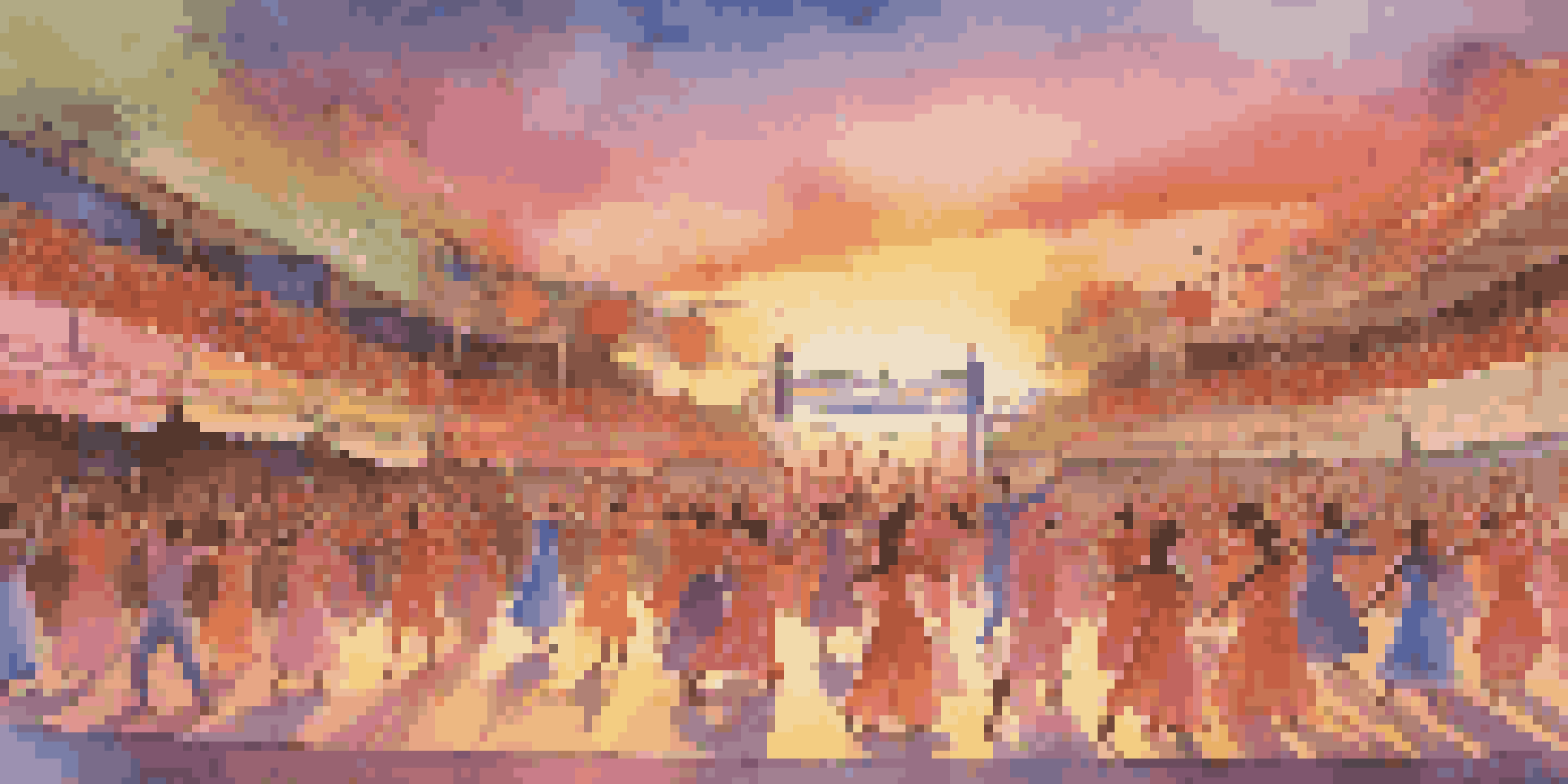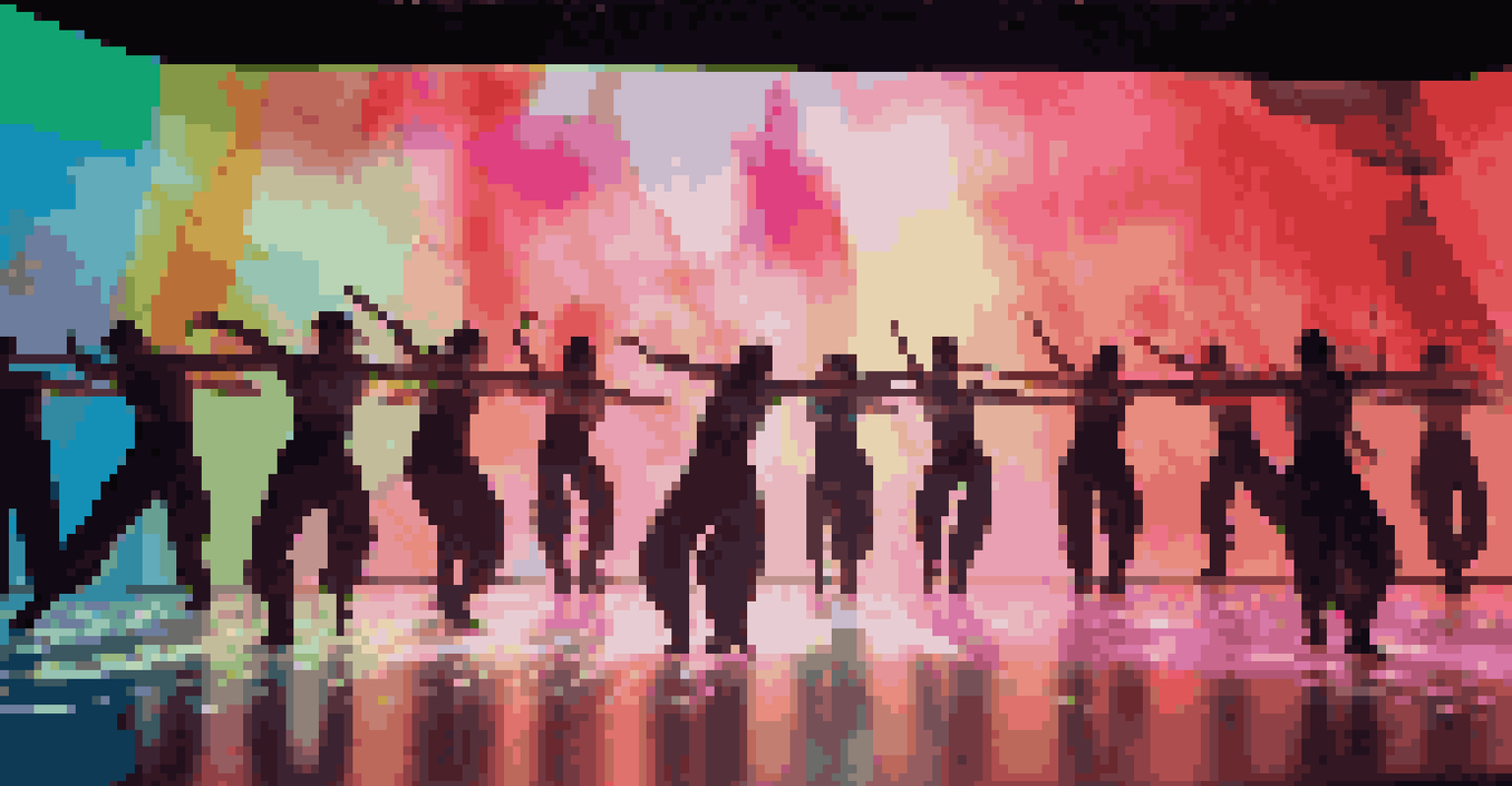The Influence of Dance Festivals on Choreographic Trends

Dance Festivals: A Hub for Creative Expression
Dance festivals serve as vibrant platforms where artists showcase their work and connect with audiences. These events not only celebrate dance but also encourage experimentation and innovation. Choreographers often use festivals as a testing ground for new ideas, sparking creativity that might not surface in traditional settings.
Dance is the hidden language of the soul.
The energy at these festivals can be infectious, inspiring both performers and viewers. They create an environment where different styles intersect, leading to unexpected collaborations and fresh choreographic trends. This melting pot of creativity fosters an atmosphere where risk-taking is not only accepted but celebrated.
Moreover, dance festivals often attract diverse audiences, which influences the direction of choreography. When choreographers see how audiences react to their work, it can shape their future creations. This feedback loop between performance and audience engagement is vital in evolving dance styles.
The Role of Cultural Exchange in Choreography
Many dance festivals emphasize cultural exchange, bringing together artists from various backgrounds. This exchange allows choreographers to incorporate different techniques and narratives into their work. For instance, a contemporary dancer might integrate traditional African dance elements, creating a unique fusion that resonates with wider audiences.

Such interactions not only enrich the dancers' skills but also broaden their perspectives on storytelling through movement. By learning from one another, artists can push the boundaries of their own styles, leading to innovative choreographic trends. The result is a tapestry of influences that reflects our globalized world.
Dance Festivals Fuel Creative Innovation
These events serve as dynamic platforms for artists to experiment and showcase new choreographic ideas.
Additionally, cultural exchange promotes inclusivity, encouraging underrepresented voices in the dance community. This inclusivity can lead to fresh ideas and narratives that have previously been overlooked, enriching the overall landscape of dance.
Networking Opportunities: Building Artistic Collaborations
Dance festivals often serve as networking hubs for artists, producers, and choreographers. These connections can lead to exciting collaborations, where choreographers merge their distinct styles to create something entirely new. An example of this is when hip-hop dancers collaborate with ballet artists, resulting in innovative performances that blend techniques.
The dance is a poem of which each movement is a word.
Such partnerships not only enhance individual careers but also contribute to the evolution of dance as a whole. Choreographers who regularly participate in festivals are often more open to exploring interdisciplinary projects, leading to the emergence of new trends. This collaborative spirit is crucial for the growth and diversification of choreographic styles.
Moreover, these networking opportunities can provide access to resources and funding that might otherwise be unavailable. By building relationships within the dance community, artists can secure support for their creative endeavors, further pushing the boundaries of what dance can be.
Audience Engagement: Shaping Choreographic Directions
The direct interaction between performers and audiences at dance festivals plays a significant role in shaping choreography. Choreographers often gauge audience reactions to understand what resonates and what doesn't, leading to adjustments and innovations in their work. This immediate feedback can be a powerful motivator for artists to refine their techniques.
Moreover, audience engagement fosters a sense of community and shared experience, which can influence the themes choreographers choose to explore. For instance, if a particular social issue resonates with audiences, artists may feel compelled to address it through their choreography, driving trends that reflect current societal sentiments.
Cultural Exchange Enhances Choreography
By bringing together diverse artists, festivals allow for the fusion of different dance styles and narratives.
This dynamic relationship between performance and audience ensures that choreography remains relevant and responsive to cultural shifts. As audiences evolve, so too does the art of dance, with festivals at the forefront of this transformation.
Innovative Technologies in Dance Festivals
The integration of technology into dance festivals has revolutionized choreographic trends. From virtual reality experiences to live streaming performances, technology allows choreographers to experiment with new forms of storytelling. For example, some artists use projection mapping to create immersive environments that enhance their performances, captivating audiences in new ways.
Additionally, technological advancements enable choreographers to reach wider audiences beyond the physical confines of the festival. When performances are shared online, they can inspire dancers from across the globe, fostering a new wave of creativity and collaboration. This digital expansion opens up endless possibilities for choreographic innovation.
As technology continues to evolve, it will undoubtedly shape the future of dance. Choreographers who embrace these tools can create groundbreaking work that challenges traditional notions of performance and audience interaction.
The Importance of Diversity in Choreography
Dance festivals often celebrate diversity, showcasing a range of styles and voices. This emphasis on inclusivity encourages choreographers to explore different cultural backgrounds and perspectives in their work. The result is a richer, more varied dance landscape that reflects the complexities of our world.
By engaging with diverse influences, choreographers can challenge the status quo and push the boundaries of their art. For instance, a choreographer influenced by both urban dance and classical ballet might create a piece that highlights the beauty of contrast while telling a compelling story. This blending of styles not only captivates audiences but also invites them to think critically about dance and its cultural significance.
Networking Drives Artistic Collaborations
Dance festivals create networking opportunities that lead to unique partnerships and the evolution of dance.
Furthermore, diverse choreographic voices inspire future generations to pursue their own unique artistic paths. When young dancers see representation at festivals, they are encouraged to explore their own cultural narratives, ultimately leading to a more inclusive dance community.
Future Trends: The Lasting Impact of Dance Festivals
As we look to the future, the influence of dance festivals on choreographic trends appears to be growing stronger. With an increasing number of festivals focused on innovation and diversity, we can expect to see a continued evolution in dance styles and narratives. Choreographers will likely keep experimenting with new forms, inspired by the vibrant environments that festivals create.
Moreover, the rise of digital platforms may lead to even more exciting collaborations and cross-disciplinary work. As artists from various backgrounds come together, we will witness the birth of new genres and trends that reflect our ever-changing society. This collaborative spirit will be essential in driving dance forward.

Ultimately, dance festivals will remain vital in shaping the future of choreography. By fostering creativity, promoting diversity, and encouraging collaboration, these events will ensure that dance continues to evolve and resonate with audiences for years to come.